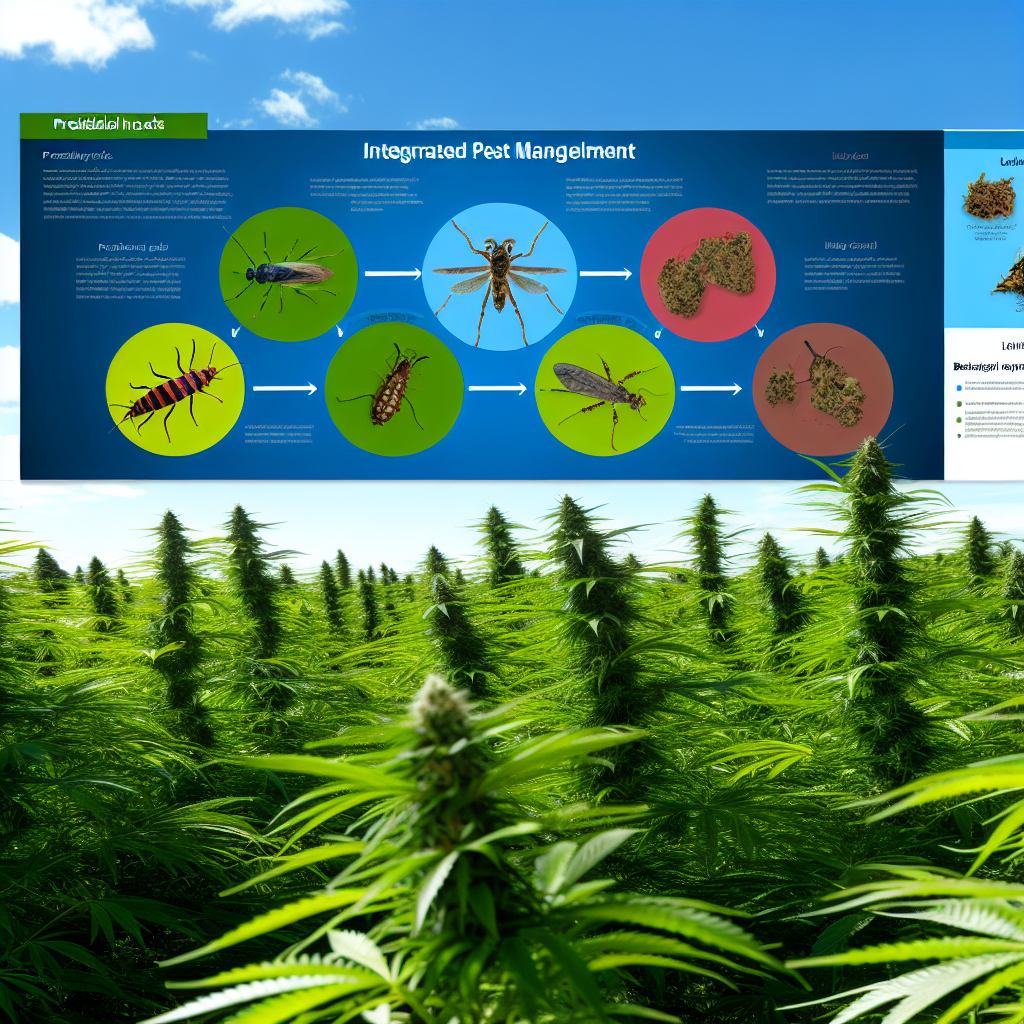Integrated Pest Management for Cannabis: Biological Control Strategies
Introduction
The cannabis industry has grown exponentially in recent years, driven by increasing legalization and consumer demand. However, cultivating high-quality cannabis is not without challenges, and one of the most pressing concerns for growers is pest management. Pests, including insects, mites, and fungal pathogens, threaten plant health, reduce yields, and compromise product quality. Traditionally, growers have relied on chemical pesticides to control these infestations, but this approach has significant drawbacks, including pesticide resistance, environmental contamination, and risks to human health.
Integrated Pest Management (IPM) is an advanced and sustainable approach to managing pests in cannabis cultivation. IPM combines multiple strategies, such as cultural, mechanical, physical, and biological controls, to minimize pest damage while reducing dependence on chemical treatments. One of the most effective and environmentally friendly components of IPM is biological control, which involves using natural enemies—such as beneficial insects, predatory mites, and microbial agents—to keep pest populations in check.
Biological control strategies are particularly relevant in cannabis cultivation, where stringent regulations restrict the use of synthetic pesticides. Many cannabis consumers and patients prefer organic, contaminant-free products, making safe and effective pest control methods essential. By leveraging biological control agents, cultivators can maintain plant health without compromising safety or regulatory compliance.
This article will explore cutting-edge biological control methods for cannabis, highlighting key predators, parasites, and microbial solutions used by professionals. Additionally, it will discuss recent scientific research supporting these approaches and offer insights into how growers can implement them effectively. Whether you’re a commercial cultivator or a home grower, understanding biological control in cannabis IPM is essential for sustainable production and superior-quality cannabis.
Harnessing Nature: Biological Control Strategies in Cannabis IPM
Biological pest control methods harness the power of nature to manage pest populations in cannabis cultivation. These methods fall into three main categories: predatory insects and mites, parasitic insects, and beneficial microbes.
Predatory Insects and Mites: Nature’s Pest Controllers
Predatory insects and mites are some of the most effective tools for controlling common cannabis pests. These beneficial bugs hunt and consume harmful pests, keeping populations under control. Some key predators include:
– Ladybugs (Hippodamia convergens) – Known for their voracious appetite for aphids, ladybugs are a natural and efficient solution for aphid infestations.
– Green Lacewings (Chrysoperla rufilabris) – Lacewing larvae are aggressive predators that feed on aphids, thrips, and whiteflies.
– Predatory Mites (Phytoseiulus persimilis/Neoseiulus californicus) – These mites are highly effective against spider mites, a common cannabis pest. N. californicus can survive on alternative food sources, making it a great option for long-term pest suppression.
Parasitic Insects: Nature’s Tiny Assassins
Parasitic insects lay their eggs inside or on pests, eventually killing them. These insects are highly effective in controlling pests without impacting plant health. Examples include:
– Parasitic Wasps (Aphidius colemani/Encarsia formosa) – These tiny wasps target aphids and whiteflies by laying eggs within them. Once hatched, the larvae consume the host from the inside out, eliminating the pest.
– Steinernema and Heterorhabditis Nematodes – These microscopic, soil-dwelling nematodes parasitize fungus gnat larvae, thrips, and root-dwelling pests. They release bacteria that quickly kill the host.
Beneficial Microbes: The Power of Invisible Protectors
Microbial agents, including fungi and bacteria, can provide excellent biological control for cannabis pests and pathogens. Commonly used microorganisms include:
– Beauveria bassiana – This entomopathogenic fungus infects and kills insects such as aphids, whiteflies, and thrips by penetrating their outer shell and growing within their bodies.
– Bacillus thuringiensis (Bt) – A natural bacterium that produces toxins lethal to caterpillars and insect larvae, Bt is an excellent control agent for budworm infestations.
– Pseudomonas fluorescens – This beneficial bacterium helps suppress soil pathogens and improves plant resilience.
By incorporating these biological control strategies into an IPM plan, cannabis growers can sustainably manage pest populations while maintaining plant safety and product integrity.
Scientific Research Supports Biological Control in Cannabis
Recent research has reinforced the effectiveness of biological control strategies in cannabis cultivation.
– A study published in *Insects* (2021) found that Phytoseiulus persimilis was highly effective in reducing populations of spider mites in controlled cannabis environments, making it a preferred natural option over chemical miticides ([Moraes et al., 2021](https://www.mdpi.com/2075-4450/12/3/195)).
– Another study in *Journal of Integrated Pest Management* (2022) emphasized the role of Beauveria bassiana as an effective fungal biocontrol agent against whiteflies and aphids. The application of this fungus led to a significant reduction in pest population without harming cannabis plants or beneficial insects ([Shrestha et al., 2022](https://academic.oup.com/jipm/article/13/1/12/6584214)).
These findings underscore the growing trend toward IPM-based biological control in cannabis cultivation.
With increasing concerns over pesticide residues in cannabis products, regulatory bodies worldwide are enforcing stricter limits on chemical pesticide use. A report published in the *Cannabis Science and Technology Journal* (2023) highlighted how large-scale cannabis enterprises have successfully implemented beneficial insects and fungal treatments to remain compliant with health standards ([Cannabis Sci. Tech., 2023](https://www.cannabissciencetech.com/view/biological-pest-control-in-cannabis-production)).
By integrating biological control methods with best cultivation practices, growers can reduce dependency on chemicals, improve ecosystem balance, and cultivate high-quality cannabis while adhering to evolving market regulations and consumer preferences.
Conclusion: The Future of Cannabis Pest Management is Biological
Biological control strategies are an essential component of Integrated Pest Management (IPM) for cannabis, offering safe, sustainable, and effective solutions for managing pests. With a growing body of scientific research confirming the efficacy of beneficial predators, parasitic insects, and microbial agents, the cannabis industry is moving away from chemical pesticides in favor of more environmentally responsible alternatives.
By leveraging these biological control methods, cannabis professionals and cultivators can protect their crops, ensure product safety, and contribute to a cleaner, more sustainable industry. As cannabis markets expand, adopting scientific IPM strategies will be key to long-term success.
Summary:
Integrated Pest Management (IPM) is a sustainable approach to managing pests in cannabis cultivation. One of the most effective and environmentally friendly components of IPM is biological control, which involves using natural enemies such as beneficial insects, predatory mites, and microbial agents to control pests. Recent research has confirmed the efficacy of biological control strategies in cannabis, with studies highlighting the use of predatory mites, entomopathogenic fungi, and beneficial bacteria. By adopting these methods, cannabis growers can protect their crops, ensure product safety, and contribute to a more sustainable industry.
References:
[1] Moraes, G. J. D., et al. (2021). “Efficacy of Phytoseiulus persimilis in Spider Mite Control on Cannabis.” *Insects*, 12(3), 195. https://www.mdpi.com/2075-4450/12/3/195
[2] Shrestha, G., et al. (2022). “Use of Beauveria bassiana Against Whiteflies and Aphids in Cannabis Cultivation.” *Journal of Integrated Pest Management*, 13(1), 12. https://academic.oup.com/jipm/article/13/1/12/6584214
[3] *Cannabis Science and Technology Journal* (2023). “Biological Pest Control in Cannabis Production.” https://www.cannabissciencetech.com/view/biological-pest-control-in-cannabis-production




